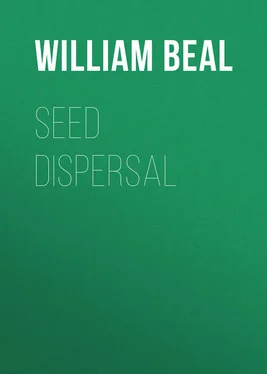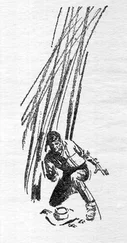William Beal - Seed Dispersal
Здесь есть возможность читать онлайн «William Beal - Seed Dispersal» — ознакомительный отрывок электронной книги совершенно бесплатно, а после прочтения отрывка купить полную версию. В некоторых случаях можно слушать аудио, скачать через торрент в формате fb2 и присутствует краткое содержание. Жанр: foreign_antique, foreign_prose, на английском языке. Описание произведения, (предисловие) а так же отзывы посетителей доступны на портале библиотеки ЛибКат.
- Название:Seed Dispersal
- Автор:
- Жанр:
- Год:неизвестен
- ISBN:нет данных
- Рейтинг книги:5 / 5. Голосов: 1
-
Избранное:Добавить в избранное
- Отзывы:
-
Ваша оценка:
- 100
- 1
- 2
- 3
- 4
- 5
Seed Dispersal: краткое содержание, описание и аннотация
Предлагаем к чтению аннотацию, описание, краткое содержание или предисловие (зависит от того, что написал сам автор книги «Seed Dispersal»). Если вы не нашли необходимую информацию о книге — напишите в комментариях, мы постараемся отыскать её.
Seed Dispersal — читать онлайн ознакомительный отрывок
Ниже представлен текст книги, разбитый по страницам. Система сохранения места последней прочитанной страницы, позволяет с удобством читать онлайн бесплатно книгу «Seed Dispersal», без необходимости каждый раз заново искать на чём Вы остановились. Поставьте закладку, и сможете в любой момент перейти на страницу, на которой закончили чтение.
Интервал:
Закладка:
4. How nature plants lilies. —Lilies grow from bulbs which are planted six inches beneath the surface. Do you know how nature plants them? A seed starts and becomes a small plant on the surface of the leaf mould or a little beneath; little roots push downward and to right and left; and later, after getting a good hold below with numerous branchlets, the slender roots shorten and tug away at the tiny bulb above, as much as to say, "Come down a little into mother earth, for cold winter is approaching and there will be danger from frost." The young bulb is drawn down an inch more or less, the slender roots perish with the growing year, but the bulb is preserved. The seedling was well planned; for while it had yet tender leaves during its first year, starch and protoplasm were stored up in the thickened scales of the bulb. During the second spring some of this food in store is used to send down another set of slender roots with the message to gather in more water, potash, phosphorus, nitrogen, and other substances to help grow a larger bulb. In late summer and autumn the new roots contract and pull away at the greater bulb, and down it goes into the ground another inch or so. I have a theory as to how it finally comes to be drawn down just deep enough and no more, but I will not venture to give it. This process is repeated from year to year till the proper depth is reached for preserving the full-grown bulb. And this is the way nature plants bulbs.
In a similar manner young slender roots well anchored in the soil, at or near the close of the growing season, pull downward and outward large numbers of bulblets that form around a parent bulb of some kinds of leeks, tulips, star-of-bethlehem, globe hyacinth, and monkshood. The pull of the roots is much greater to one side than downward, because most of the longest roots extend sidewise. Marilaun reports that a certain lawn in Vienna was mown so frequently that tulips could not go to seed, but after twenty years, from a very few bulbs planted near each other, a space twenty paces in diameter was well covered by tulips. And this is one way tulips travel, slow and sure.
5. Roots hold plants erect like ropes to a mast. —Did you ever lift vines of cucumbers, squashes, and the like, where they had rooted at the joints, and observe how forlorn they looked after the operation, with leaves tipped over, unable to remain erect? While growing, the stem zigzags or winds about more or less, and thus enables it to hold the leaves erect; besides, the tendrils catch on to weeds and curl up tight, and the roots at the joints are drawn taut on each side after the manner mentioned above, and act like ropes to a mast to hold the stem in its place, and thus help to hold the leaf above erect.
6. How oaks creep about and multiply. —Oaks come from acorns; everybody knows that. The nuts are produced in abundance, and those of the white oak send out pretty good tap roots on the same year they fall. Some of the nuts roll down the knoll or are carried about by squirrels or birds, as mentioned elsewhere. Let me tell you one thing that I discovered the white oaks were doing in the sand of the Jack-pine plains of Michigan. In dry weather the dead grass, sticks, and logs are often burned, which kills much or all that is growing above ground. In this way little maples, ashes, witch-hazels, willows, huckleberries, blackberries, sweet ferns, service berries, aspens, oaks, and others are often killed back, but afterward sprout up again and again, and, after repeated burnings, form each a large rough mass popularly known as a grub . The grubs of the oak are well known; the large ones weighing from 75 to 100 pounds each. To plow land where grubs abound requires a stout plow and several pairs of horses or oxen.
A small white oak, after it has been many times killed to the ground, dies in the middle and sprouts at the margins, and finally the main root perishes, and two roots, with branches a little distance apart, support each a cluster of stems above ground.
There can be no doubt that young oak trees slowly move in this manner from one place to another. If in fifty years we have two distinct grubs or branches, three or four feet apart, where the connecting part has finally died out, I see no reason why in another fifty years each one of the two may not again have spread and divided, giving us at least four grubs, or clusters of sprouts, all originally coming from one acorn; and so the matter might go on. This is slow traveling, I admit, but there is nothing to hinder nature from taking all the time she wants.
CHAPTER III
PLANTS MULTIPLY BY MEANS OF STEMS
7. Two grasses in fierce contention. —In growing a lawn at the Michigan Agricultural College, a little Bermuda grass was scattered with June grass, and the struggle has been most interesting. In the spring and for six weeks in autumn, when moisture usually abounds and the weather is cool, June grass thrives and little else is seen. In the dry, hot weeks of July and August, June grass rests and the Bermuda, which continues to spread, assumes control of the lawn, with but little of the June grass in sight. Each struggles for possession and does the best it can, and to some extent one supplements the other, with the result that at all times from spring to fall there is a close mat of living green which delights the eye and is pleasant to the feet that tread upon it. In soft ground, with plenty of room, a bit of quick or quack grass, or Bermuda, will extend in a year three to five feet or more in one direction.
June grass, quick grass, Bermuda grass, redtop, and white clover, wherever opportunity offers, spread by means of jointed stems, creeping and rooting at every joint on the surface of the ground or a little way below. These are not roots at all, but true stems somewhat in disguise. Here may also be mentioned, as having similar habit, artichokes, peppermint, spearmint, barberry, Indian hemp, bindweed, toadflax, matrimony vine, bugle-weed, ostrich fern, eagle fern, sensitive fern, coltsfoot, St. John'swort, sorrel, great willow-herb, and many more.
8. Runners establish new colonies. —The spreading of strawberries by runners must be familiar to every observer. In 1894 a student reported that a wild strawberry plant in the botanic garden had produced in that year 1230 plants. Weeds were all kept away, the season was favorable, the soil sandy; but on one side, within a foot and a half, progress was checked by the presence of a large plant of another kind. The multiplication of this plant by seeds, in addition to that by runners, would have covered a still greater area of land. Other plants with runners much like the strawberry are: several kinds of crowfoot, barren strawberry, cinquefoil, strawberry geranium, and orange hawkweed. Plants of the star cucumber, one-seeded cucumber, grapes, morning-glories, and others, spread more or less over bushes or over the ground, and are thus enabled to scatter seeds in every direction.
9. Branches lean over and root in the soil. —A black raspberry grows fast in the ground and has to stay in one spot for life. It has neither legs, feet, nor wings, and yet it can travel. The bush takes deep root and spreads out its branches, which are sometimes ten feet or more in length; the tips of these branches curve over to the ground six feet away, and finally take root; from these roots new colonies are formed, five to twenty in a year from one bush.
True, the old roots do not get far, and the new plants only get about six feet in one season, but they have made some progress. This is rather slow locomotion, you say; but let us look a little farther, remembering that a seed is a little plant packed ready for transportation. This second mode of spreading will be described on a future page.
Читать дальшеИнтервал:
Закладка:
Похожие книги на «Seed Dispersal»
Представляем Вашему вниманию похожие книги на «Seed Dispersal» списком для выбора. Мы отобрали схожую по названию и смыслу литературу в надежде предоставить читателям больше вариантов отыскать новые, интересные, ещё непрочитанные произведения.
Обсуждение, отзывы о книге «Seed Dispersal» и просто собственные мнения читателей. Оставьте ваши комментарии, напишите, что Вы думаете о произведении, его смысле или главных героях. Укажите что конкретно понравилось, а что нет, и почему Вы так считаете.












